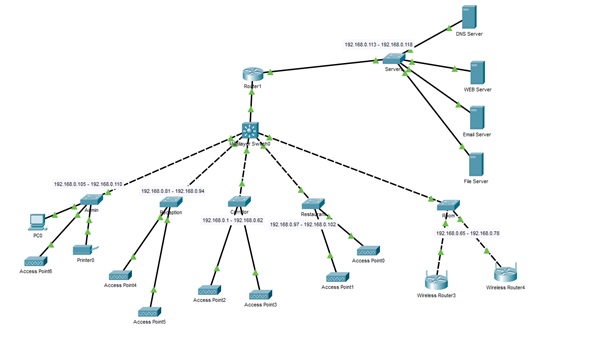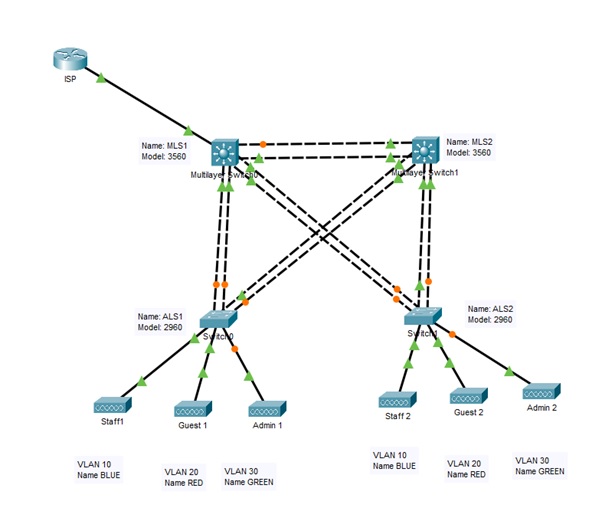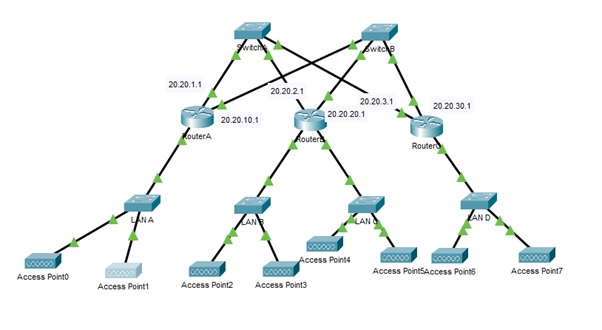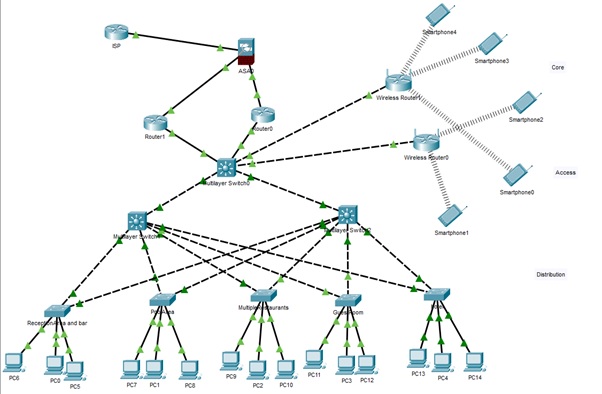Advanced Network Design
Project Scope and Requirement:
Contribution Summary
Design 1
For the preparation of the report I have conducted survey on the web for finding different types of network technology and network equipment and use it for designing the network. I have conducted meeting with all the team members and prepared a project schedule for dividing roles and responsibility to each of the team members. A have learned the use of packet tracer and shared my learnings with my team members for development of the network diagram. Also, the whole network should support 1500 devices simultaneously. All of the access points which will be used throughout the hotel must be secured and the login credentials of this access points should be only shared with the authenticated users.
Design 2
For the preparation of the network design I have thoroughly studied the case study for finding its requirement. All the customers and guests of this should be able to connect to the wireless access points and should be able to enjoy a high-speed network coverage without any type of issues [1]. This network will be mainly used for the entertainment purposes and also the users will be able to stream HD content through this network. The network diagram is prepared aligning the requirement of Al Hayat hotel apartments in Sharjah. For the design I have used ether channel configuration such that there is sufficient bandwidth available for the backbone of the network and no congestion or collision occurs.
Design 3
In the current aspect, the main project is implementing the wireless network coverage in the Al Hayat hotel apartments in Sharjah. The current scope and the requirement for this project is that it must be secured enough to use and proper connectivity should be provided to each of the apartment of in this building. My role in the project was to create the network design such that all the area of the hotel can be covered. I took care of the coverage area of the hotel and overlapping of the wireless signal such that the user connected with the wireless network can move seamlessly between different areas of then network. Coverage is one important aspect of this project which should be taken care of in this project. Here, the strong signals should be available in each of the corner of every room so that any type of performance drop does not occurs. I used redundant link for connecting the network equipment for improving the network performance.
Design 4
I researched on the traditional design that are followed in the hotels and implemented it for the development of the network design. For the development of the network I used a firewall and connected with the router such that the entry and exit point can be secured. I focused on security and performance of the network and thus used three level hierarchical model for the development of the network. Regarding this access control list (ACL) will be implemented to restrict the unknown users and the guests from entering into the network so that internal servers of the hotel can be secured [2].
Network Design and Analysis:
From the analysis of the overall network various of advantages has been identified for the current network. The used topology foe the current network is the main advantage in this case. The layered topology design of the current network can increase the bandwidth and the availability of this designed network [5]. Here, it is one important advantage for the current network. Also, through this layered topology approach different sections of the hotel can be covered very easily and here it will also provide a centralised control over the network. Also, the protocol has been chosen for this network very wisely that it can transfer the data packet from one point to another point using the shortest path available. In this way, overall speed of communication will be improved. Therefore, these are the main advantage of this network.

Advantage
The network design is simple and easy to manage
- Vlan is used for subnetting the network and improve network performance
- Servers are kept in different subnet for managing its access
- DHCP configuration can be used for enabling plug and play support of network equipment’s
- VTP configuration is used in the switch for enabling centralized management of vlan
Disadvantage
- No redundant device is used in the network for if the multilayer switch fails the whole network stops working
- A single cable is used for connecting multilayer switch with router and it can cause bottleneck
- Inter operation can become a problem with the use of vlan

Advantage
- Port channel configuration can be used for increasing the bandwidth
- Spanning tree configuration is used for enabling redundancy of link
- The broadcast storms in the network can be prevented
- It balances the traffic load in the network
Disadvantage
- It needs costly high performance network device for development
- More cables are needed for connecting the devices
- Increases the complexity of the network
- Increases the management cost of the network

Advantage
- It follows three level hierarchical model for designing the network easily
- It has the support of traffic multiplexing
- It can save cost of the network equipment’s
- It can increase security with use of access control list in routers
Disadvantage
- It increases the cost of cabling
- Addition of new device in the network needs multiple cables to be laid out

Advantage
- It follows three level hierarchical model for designing the network easily
- It has the support of traffic multiplexing
- It can reduce collision with the use of redundant links
- It can increase security with use of access control list in routers
Disadvantage
- It increases complexity of the network with the use of firewall
- Firewall rules are needed to be created aligning the boyishness needs
- It needs costly network equipment’s for vlan management
Considering the disadvantage, the main disadvantages of this network are the robustness of the network, lack of independence and overall cost of the network. In this network robustness related issue can occur. Also, due to the centralization it also lacks a proper degree of independence [6]. Also, due to the utilization of high-quality equipment cost is quite high in this case, but overall, this is a cost-effective solution due to the performance of the solution.
Network Performance:
The main requirement for this project is a specific type of wireless access point which is manufactured by the TP-Link itself. This wireless access point is known as the EAP 320. This device is an AC1200 wireless celling mount access point and it also supports the both the band of 2.4 GHz and the 5 GHz. It can provide a speed up to 1.2 Gbps [3]. This device also supports the controller software through which it can be controlled easily. It also has a captive portal through which guest authentication can provided conveniently. It does also support the functionality of power over ethernet (PoE) for the flexible instalment, as per the requirement of Al Hayat Hotel management [4]. Also, multi-user environment is another benefit of using this technology. Apart from this wireless access points, there are several of other common type of devices which will be required for preparing this network and these includes router, switches, connecting cables and firewall devices. Considering all of the networks in this case, there are several of factors which can influence the performance of the network. The first factor is the total number of connected devices in the network. The greater number of end user device connects, the more performance of the system drops. Also, bandwidth of the connection directly affects the network performance. Here, high bandwidth means high performance and reduced bandwidth means reduced performance [7]. These are the main factors which are capable of affecting overall performance of a network. There are several of other factors which can also affect the network performance, and these are the network latency, network traffic type and the overall number of transmission related error.
Innovative Ideas:
There are several of innovative ideas which can be used for improving the performance of this current developed network. These innovative approaches are discussed in the following section.
- SDN: In the current context the SDN or software defined network can be useful for improving overall network as it can automate the configuration and in this way traceability of that network is improved [8]. Also, dynamic structuring of the SDN reduces the chances of DDoS attack.
- 5G: By using the 5G connection both of the network bandwidth and the connectivity speed both will be increased which is a major improvement to the network [9].
- Cloud: The cloud is capable of provide remote connection to the network, through which this network can be controlled remotely which will improve the overall network configuration.
- Multi-Band Router: The Multi-Band Router is capable of improving the connection as it provides a faster connection compared with the single band router [10].
Summary:
From the above discussion it can be concluded that proper network design is important for improving the overall performance of a network. In this paper a network solution has been presented for the Al Hayat Hotel apartment in Sharjah. Here, this the Al Hayat hotel of Sharjah wanted to implemented a wireless network connection for their customers and guests depending on various of criteria. The current network has been designed by following all the requirement of Al Hayat hotel. Here, wireless access points have been installed all over the hotel and for that EAP 320 has been used. Also, appropriate analysis of the current implemented network has been discussed within this report. Following that important factors which can affect the performance of the network has been also identified. Lastly, innovative ideas for improving the overall performance of the network has been also assessed.
References:
[1] E. Özceylan, N. Demirel, C. Çetinkaya and E. Demirel, "A closed-loop supply chain network design for automotive industry in Turkey", Computers & Industrial Engineering, vol. 113, pp. 727-745, 2017. Available: 10.1016/j.cie.2016.12.022
[2] M. Fattahi, K. Govindan and E. Keyvanshokooh, "Responsive and resilient supply chain network design under operational and disruption risks with delivery lead-time sensitive customers", Transportation Research Part E: Logistics and Transportation Review, vol. 101, pp. 176-200, 2017. Available: 10.1016/j.tre.2017.02.004
[3] N. Al-Rumayyan, N. AlMadi, N. Alay and S. Al-Megren, "Evaluating TP-Link Smart Plug", Proceedings of the 17th International Conference on Mobile and Ubiquitous Multimedia - MUM 2018, 2018. Available: 10.1145/3282894.3289735
[4] J. Palacios, D. Steinmetzer, A. Loch, M. Hollick and J. Widmer, "Demo", Proceedings of the 12th International Workshop on Wireless Network Testbeds, Experimental Evaluation & Characterization - WiNTECH '18, 2018. Available: 10.1145/3267204.3268070
[5] C. She, Z. Chen, C. Yang, T. Quek, Y. Li and B. Vucetic, "Improving Network Availability of Ultra-Reliable and Low-Latency Communications With Multi-Connectivity", IEEE Transactions on Communications, vol. 66, no. 11, pp. 5482-5496, 2018. Available: 10.1109/tcomm.2018.2851244
[6] A. Chow, R. Sha and S. Li, "Centralised and decentralised signal timing optimisation approaches for network traffic control", Transportation Research Part C: Emerging Technologies, vol. 113, pp. 108-123, 2020. Available: 10.1016/j.trc.2019.05.007
[7] B. Dasgupta, D. Valles and S. Mcclellan, "A Comparison of MLA Techniques for Classification of Network Bandwidth Loss", 2018 International Conference on Computational Science and Computational Intelligence (CSCI), 2018. Available: 10.1109/csci46756.2018.00155
[8] K. Foerster, S. Schmid and S. Vissicchio, "Survey of Consistent Software-Defined Network Updates", IEEE Communications Surveys & Tutorials, vol. 21, no. 2, pp. 1435-1461, 2019. Available: 10.1109/comst.2018.2876749
[9] M. Shafi et al., "5G: A Tutorial Overview of Standards, Trials, Challenges, Deployment, and Practice", IEEE Journal on Selected Areas in Communications, vol. 35, no. 6, pp. 1201-1221, 2017. Available: 10.1109/jsac.2017.2692307
[10] V. Pano, I. Tekin, I. Yilmaz, Y. Liu, K. Dandekar and B. Taskin, "TSV Antennas for Multi-Band Wireless Communication", IEEE Journal on Emerging and Selected Topics in Circuits and Systems, vol. 10, no. 1, pp. 100-113, 2020. Available: 10.1109/jetcas.2020.2974236


